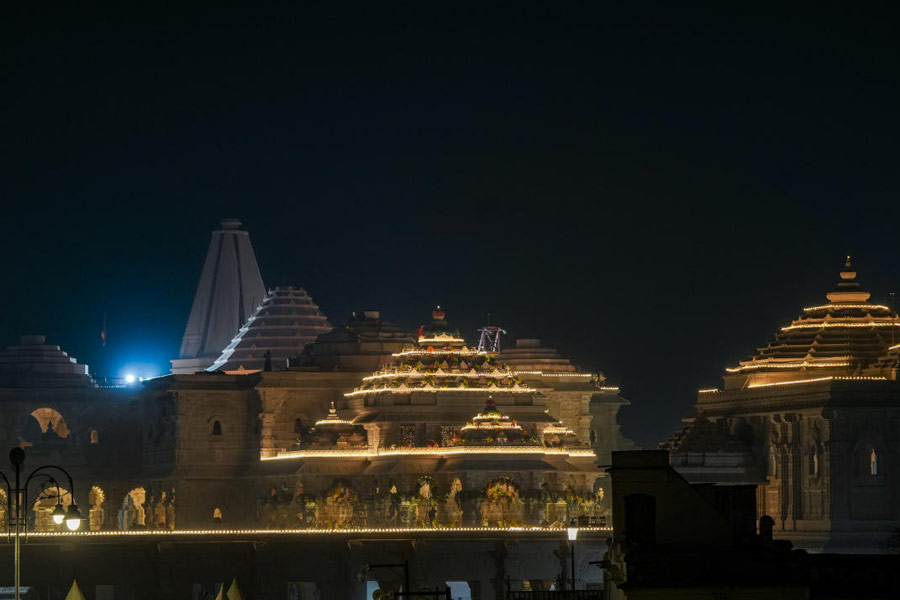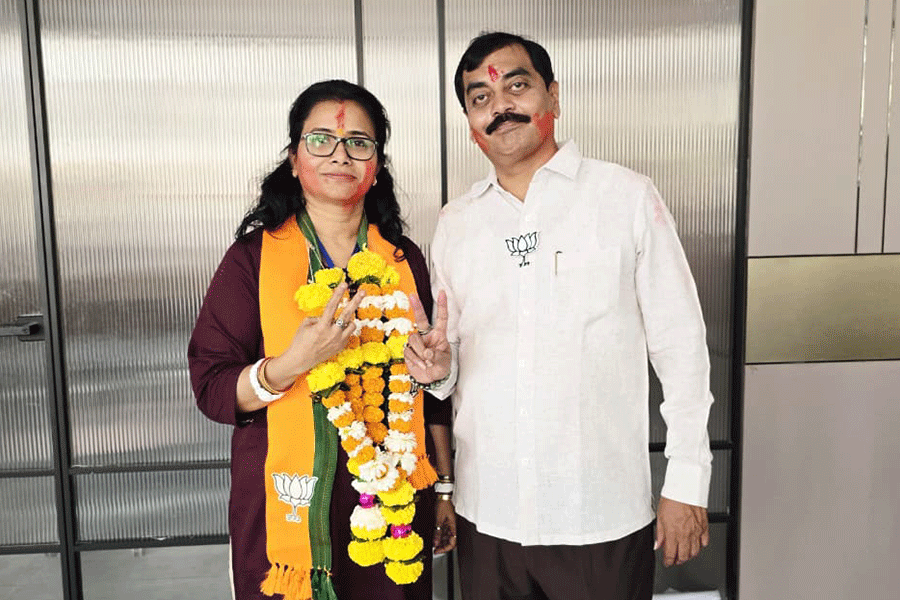As you approach the hub of solemn Hindu religiosity that the Ram temple is now, chirpy strains of “Allah ye ada kaisi hai in haseenon mein, roothe pal me na mane mahinon mein” seem to introduce a somewhat surprising note.
It’s the brass band of the Provincial Armed Constabulary playing a song from the 1968 Bollywood thriller, Mere Hamdam Mere Dost, while perched on the raised platform in the middle of a newly built roundabout named after Lata Mangeshkar.
Getting into the mood of the moment — or perhaps not — the band plunges into a rendition of Allama Iqbal’s Sare Jahan Se Achcha and one of Mahatma Gandhi’s favourites, Raghupati Raghav Raja Ram.
But what spoils the music lover’s enjoyment somewhat is not just the mediocre skills of the players but also the loudspeaker at a police booth, barely 10 yards away, sticking its oar in.
“Ek hi nara, ek hi naam/ Jai Shri Ram, Jai Shri Ram,” it blares, competing with the brass band. “Layenge ham layenge/ Ram Rajya ham layenge”, it continues, and finally: “Jaat paat me mat padna/ Hamein Hindu Rashtra banana hai.”
Welcome to Ayodhya, where many worlds seem to collide, or blend, today.
One of the members of the PAC band said they had “orders” to play at the roundabout from Saturday till Tuesday, implying the exercise is meant for the entertainment of the tens of thousands of devotees descending on the pilgrimage town ahead of Monday’s Ram temple consecration.
At the police booth, a cop merely laughed when asked who had asked them to use the PA system, meant for issuing traffic instructions, to play pro-Hindutva chants.
Two other worlds that seem to have blended are those of the sadhu and the amateur sadhu — the ordinary pilgrim inspired by the occasion into donning saffron and breaking into song and dance and, solely on that strength, attracting their own “followers”.
Ram Reddy, a middle-aged civil contractor from Odisha who had arrived on Friday, was dressed in saffron dhoti-kurta and slippers with, somewhat incongruously, a black backpack strapped to his shoulders.
A knot of fellow pilgrims followed him as he walked back and forth along the 1km stretch between the Lata Mangeshkar Chawk and the yet-to-be-built gate of the Ram temple, singing verses from the Ramayan.
“I came here alone, and some people began following me as I walked in a trance, singing religious songs. God is great and I feel like a seer here,” he told The Telegraph.
Asked about the apparently conflicting messages being put out by the PAC band and the police booth’s loudspeakers, he said: “We understand everything — the music and the slogans — but I don’t want to discuss it at the moment because everybody is immersed in the oceanic presence of Lord Ram in Ayodhya.”
Palaka, a fifty-something devotee from Kerala who uses a single name, stood a few metres from Reddy while his own band of “followers” kept up a chant of “Govinda Palaka zindabad”.
Palaka, who was in white kurta-lungi, a cream shawl and black leather slippers, told this newspaper: “I’m a religious man and it’s natural that people will follow me when the atmosphere is intensely religious.”
He didn’t know why the chanters had prefixed “Govinda” to his name.
Babaji Raghav, 50, who had arrived in Ayodhya on Thursday from Odisha, has attracted “followers” by playing crash cymbals and dancing. Sporting a saffron pullover, white lungi, plastic chappals and long, flowing hair, Babaji looked the part.
“I have been a sadhu for many years and am now feeling like a big saint in Ayodhya by the grace of God. Some strangers are accompanying me round the clock and offering me water and food,” he said.
Asked why, one of the men in Babaji’s entourage, a youth who identified himself as Anshuman Kumar and said he had come from Jharkhand, said: “Babaji seems to have some spiritual powers.”
But he cited another reason too: “Babaji is also very helpful. He easily gets a place to sleep in any temple here in the night, and accommodates his followers too.”
As for the local sadhus and sadhvis themselves, most were occupied in giving interviews to news channels in the more than 50 “camps” — stages, tents and canopies — set up in Ram Ki Paidi along the Saryu.
Ram idols
The new idol of Ram Lalla was washed with water from five holy rivers, brought in metal pitchers, on Saturday and placed in the ground-floor garbh grih or sanctum sanctorum of the new temple. The old idol from the makeshift temple, too, was brought to the new shrine.
Both idols were offered sugar and fruits, with yajna and hawan performed amid the chanting of hymns.
The new idol will be consecrated on January 22 in the sanctum sanctorum while the old idol will be installed a short distance away.
The makeshift temple was closed on Saturday but will be opened after January 22. A source said a new idol would be installed there because the Shri Ram Janmabhoomi Teerth Kshetra trust that manages the new temple wants the memory of the old shrine to remain fresh in people’s minds.
River ‘cleaning’
A source in the trust said Prime Minister Narendra Modi, who will be the chief guest at the consecration, was likely to take a dip in the Saryu before the event.
“Modi may take a bath in the river at Kachcha Ghat. Security personnel and chief minister Yogi Adityanath visited the spot on Friday and found it appropriate because the government guesthouse is barely a few metres from there and the PM may like to go there for a few minutes after the holy dip,” the source said.
“Since there was not enough water in the river, about 3,000 cusec water was released from the Sharda and Girija barrages (in Lakhimpur Kheri) to increase the water level and make the river cleaner.”











